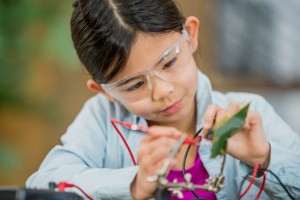Where to Begin? Getting Started With Exemplars Science
By Tracy Lavallee, 4th Grade Teacher and Exemplars Science Consultant

Exemplars Science is not a stand-alone program.
Rather it is a supplemental program to help schools and districts bring standards-aligned, inquiry and performance-based instruction and assessment into their classrooms. The tasks can be used in a multitude of ways, for both instructional and assessment purposes.
Tips for Getting Started With Exemplars Science
- Begin by looking at your curriculum. What units of study are you currently teaching? What concepts and skills are you assessing? When do you assess your students’ understanding? Where might you add formative assessment? Where could you add more inquiry-rich tasks? Do you currently use a rubric for assessment?
- Start small. Pick one task to add to your existing unit, for instruction or assessment. Try it out.
- Work with colleagues. It is very helpful to meet with colleagues and discuss possible tasks to use for assessment. This will add consistency at grade levels and can provide opportunities for teachers to share and analyze student work together. These rich conversations can help facilitate more effective instruction and differentiation, and deepen students’ understanding of sometimes complex concepts. It is also an opportunity to help each other be the best teachers we can be for our students.
Ways to Use Exemplars Science
- Pre-Assessment Task: Often we forget the importance of pre-assessing students to see what they already know about a particular concept. A pre-assessment is a powerful tool for teaching. It gives us a starting place. It helps us to identify any misconceptions students may have so that we can design our instruction to address those.
- Anchor Task: An anchor task is used at the beginning of a unit to engage students with the content and the materials. It can also be used to pre-assess students’ prior knowledge and a way to elicit misconceptions students may have. But its main purpose is engagement with the phenomenon. For a unit on electrical circuits, “Can You Light the Bulb?” (a 3-5 Exemplars investigation) is a great anchor task to try. During this investigation, students use materials to explore how to light a bulb, engage with the big ideas of the unit, grapple with a problem, collaborate with others, and communicate their thinking and learning.
- Inquiry/Content Task: Many of the Exemplars tasks may be used to enrich units of study by adding more inquiry-based learning. They are also designed to help students deepen their conceptual understanding. For example, the 3-5 investigation, “Learning About Electricity, Part 2: How Many Electrical Circuits Can You Make?” engages students with concepts of parallel and series circuits and helps them to understand and demonstrate the difference. It also provides an opportunity for students to practice inquiry skills such as observation, designing and testing ideas, gathering data and communicating explanations and solutions. Many Exemplars science tasks are effective for teaching and practicing the skills of science and engineering.
- Formative Assessment: Formative assessments happen throughout a unit. They can be very intentional as a means to gather information about what your students know and are able to do at different points. They can also be very informal check-ins to see what instructional modifications or changes need to be made to help students with certain concepts and skills. An example of a formative assessment in a unit on electricity might include the task, “Can You Get Two Light Bulbs to Light?” In this setting, this 3-5 task may be used to check on students’ understanding of circuits and how they work. Most Exemplars tasks can be used for formative assessment purposes.
- Cumulative Assessment: Cumulative assessments are an important part of classroom assessment. They not only ask students to demonstrate conceptual understanding but serve as real-world opportunity for them to apply that understanding. Exemplars performance tasks are designed to be real-world applications of knowledge and skills. The 3-5 investigation “Can You Wire a House?” may be used at the end of the unit to assess students’ understanding of the concepts and their ability to communicate their understanding. It also asks students to apply their understanding to solve a problem and design a possible solution.
These are just a few suggestions for getting started with Exemplars Science. There is no right or wrong way to begin. The important thing is to begin. Have fun with it! Our tasks are teacher- and student-tested and approved. We are also here to help you and your school as you implement Exemplars into your teaching and to support you as you go.

